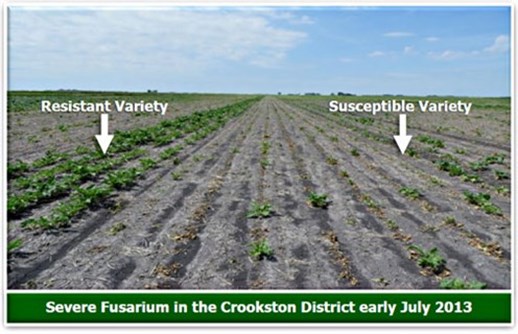582 - Now Is Also The Time To Plan Your 2014 Nitrogen Management Strategy
Weather has been ideal for development of several disease problems in recent weeks. Resistant weed problems are on the increase in many areas in 2013.
Q. Why has Fusarium root rot increased in incidence and severity in 2013?
A. Fusarium has been severe in Clay County and other isolated areas for about 10 years. It is becoming much more severe in the Crookston district and some new areas in the Hillsboro district. Probable reasons are short rotations, and especially planting susceptible varieties that build inoculum. The disease is favored by alternating wet and dry periods, poor soil structure and water logging. Choose the most tolerant varieties available for 2014. Many of these varieties have very good revenue per acre.

Q. What is the Cercospora leafspot outlook for 2013?
A. Daily infection values have been in the severe category on many, many days in the past three weeks. Use tank mixes of fungicides for best results and excellent fungicide resistance management. Severe daily infection values have been observed for three to seven day periods at most NDAWN weather stations in the RRV. Cercospora had been identified in all districts by mid to late July.
Q. Have glyphosate resistant weed problems become more severe in 2013?
A. Yes without a doubt occurrences of resistant weeds are becoming more common. Common ragweed exhibiting resistance to glyphosate has been documented in nearly every RRV county. Resistant common waterhemp has been documented at multiple locations in Wilkin, Richland, Cass, and Clay counties. It is suspected in other counties as well. Kochia is developing resistance in more areas and is of great concern to NDSU weed scientists.
Q. What should I do to manage or prevent resistant weeds at this point in the summer?
A. Eliminate all weeds in fields to prevent seed production. Use tillage or other strategies to control any weeds in field borders. Don't let weeds in ditches and drowned out areas of fields go to seed. Evaluate effectiveness of 2013 weed control programs in all crops and make adjustments where needed for 2014. Map suspected resistant weed spots with GPS coordinates so you can monitor them in the future.
Fine Tune Nitrogen Management Plans for 2014
- Compare your crop quality to your piler and factory district averages for the past five years. If your quality is below average, is too much N use a factor?
- Consider applying 50-75 percent of total N needs this fall. Then sidedress by the 8-leaf stage in 2014 to better meet crop needs.
- Consider use of nitrification inhibitors with fall applied fertilizer.
- Consider use of slow release N fertilizer to reduce risk of N losses.
- Be sure to zone soil sample fields and variable rate apply nitrogen as necessary to maximize revenue.
Starter Fertilizer Use a Critical Management Tool
- Dramatic responses to in-furrow starters containing P were observed this spring.
- Don't eliminate starter use because of in-furrow fungicide use, both practices are very important to maximize crop revenue.
- Consider broadcast P applications to raise nutrient values in extremely low testing fields for P.
Important Reminder!
Bolter removal is required in all fields by July 15, August 15 and September 15.
